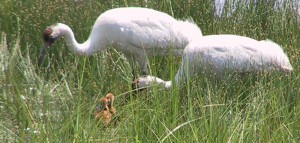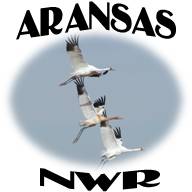Archive for May 25, 2011
Newsletter – Spring 2011
May 25, 2011Latest Flock Status
May 24, 2011Chick with “pedigree” Hatches at Necedah NWR in Wisconsin
May 17, 2011Article by International Crane Foundation — May 11, 2011
The French word for crane, grue, gives us the English word pedigree – from pied de grue, meaning literally “foot of the crane.” The shape of the crane’s foot (right) refers to a succession mark made on French genealogy charts.
On April 10th the first Whooping Crane chick (W1-11) of the season hatched in a wild nest at the Necedah National Wildlife Refuge (NWR) in central Wisconsin. The mother of this chick (W1-06) was the first chick to hatch in the wild in Wisconsin in over 100 years. It was an historic day in 2006, and now just five years later – she has produced her own wild offspring. The father (#10-03) of the new chick stems from a captive pair at the San Antonio Zoo. He was released at Necedah NWR in 2003 to learn the migration route behind an ultralight aircraft. The maternal grandparents are both “ultralight” birds. Grandmother (#17-02) was shot during migration in Indiana in 2009.
Tracking parentage and relatedness in Whooping Crane population management is vital because of the genetic bottleneck they went through in the 1930s. Genetic diversity is important because it keeps the population healthy. A team of crane experts manage the lineage of captive Whooping Cranes in a “studbook”, while the reintroduced wild birds are tracked in a database. Read more about the Whooping Crane Conservation story.
May 13, 2011 Update
The Necedah NWR reports that three Whooping Crane chicks hatched this week at the reserve. Unfortunately, the first chick, W1-11, has not been sighted recently. We still celebrate her story and the hope that all three chicks bring for the population!
Wild Whooping Crane Chicks Hatch at Necedah National Wildlife Refuge
May 12, 2011Wisconsin — May 12 2011
 The U.S. Fish and Wildlife Service’s Necedah National Wildlife Refuge (NWR) and the Whooping Crane Eastern Partnership (WCEP) are celebrating another success in efforts to reintroduce a wild migratory whooping crane population in eastern North America.
The U.S. Fish and Wildlife Service’s Necedah National Wildlife Refuge (NWR) and the Whooping Crane Eastern Partnership (WCEP) are celebrating another success in efforts to reintroduce a wild migratory whooping crane population in eastern North America.
Three whooping crane chicks hatched this week at Necedah NWR in central Wisconsin. The first chick to hatch this season was the offspring of wild whooping crane W1-06. W1-06 was hatched and raised in 2006 on Necedah NWR and is the first wild offspring from the eastern whooping crane reintroduction project started more than a decade ago.
The additional two chicks are the offspring of other well-established whooping crane pairs. Sadly, refuge biologists have been unable to locate the first chick in recent monitoring efforts. The chick may have been predated.
“Although we are disappointed by the potential loss of the first chick, we are encouraged by this first successful nesting and hatching of a wild-born chick, from a wild-born parent,” said Necedah National Wildlife Refuge Manager Doug Staller. “Refuge staff is committed to working toward the ultimate goal of a self-sustaining eastern flock of migratory whooping cranes and actively monitors additional nests of whooping crane pairs on the Refuge.”
There are approximately 105 whooping cranes in the eastern migratory population including at least 20 nesting pairs, also a record number for this reintroduced population. In addition to the three chicks hatched in the wild this week at Necedah NWR, three chicks have fledged in the wild during the course of the reintroduction project, which began in 2001.
“The Whooping Crane Eastern Partnership’s focus over the next five years is successful reproduction in the wild flock, and the recently hatched chicks, in addition to the three previously fledged wild-hatched chicks are a very promising start to achieving this goal,” said Joel Trick, acting project leader for the Service’s Green Bay Ecological Services Field Office and WCEP representative. “We continue to work to identify the factors that may contribute to nest failure, and are working to address those challenges through active nest management and captive-reared releases.”
This year marks an important transition for whooping crane recovery efforts at Necedah NWR. The effort has shifted from the population depending upon introduction of captive-reared birds to the population being supported through wild whooping cranes producing eggs, hatching chicks and fledging young.
Since whooping cranes have been absent from the upper Midwest for over 120 years, WCEP plans to continue studying factors that improve reproductive success as well as how reintroduced whooping cranes use the habitats they encounter following release. These data will refine the understanding of what determines overall success for whooping crane reintroduction in the upper Midwest.

